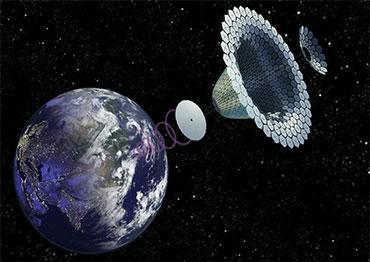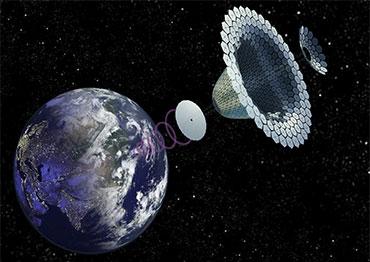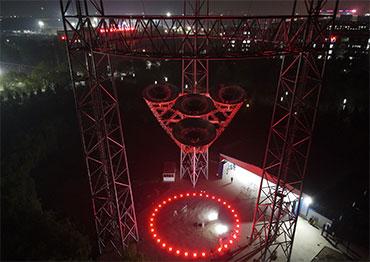All energy resources on Earth come from the Sun. Fossil fuel generates air pollution and resources are finite, while power generated by wind, sunlight and water is unstable, and currently power from renewables accounts for only 23.6 percent globally. More breakthroughs are needed in energy storage technology before the world can rely on renewable energy alone to provide a sustainable and stable energy supply.
Weather and geographic conditions restrict solar energy collection on Earth, causing a high rate of energy loss. Collecting solar energy in space has a higher collection rate and a longer collection period because of the attenuation effect of the atmosphere. Attenuation means that incoming solar radiation is weakened, scattered and absorbed by other solid and liquid particles as it passes through the Earth’s atmosphere.
Yang Shizhong, an academician of the Chinese Academy of Engineering and director of the Institute of Communication and Measurement and Control of Chongqing University, told NewsChina that because of atmospheric attenuation, power generated by ground solar power stations is limited and varies significantly based on location. For example, in northwest China, which has sufficient sunshine, a square meter of photovoltaic cells can generate 0.4 kilowatts (kW) per hour of electricity, but only 0.1 kilowatt per hour in the foggy city of Chongqing. In a geosynchronous orbit of 36,000 kilometers, power generation would be up to 10 kW to 14kW per hour. In space, diffusion of the atmosphere, seasonal changes or daily light changes do not affect solar panels. There is steady and sustained solar radiation up to 99 percent of the time, which can generate uninterrupted power with an energy efficiency dozens of times that of solar energy generated on the ground.
Microwaves and lasers are the two long-distance wireless energy transmission carriers for space solar power stations. Microwaves are more efficient, have lower cloud penetration loss, and are the safer, more mature technology.
The concept of space solar power satellites, originally known as satellite solar-power systems, was first described in 1968 by CzechUS engineer Peter Glaser as a method to transmit power over long distances (from an orbiting station to the Earth’s surface) using microwaves from a very large antenna (up to one square kilometer) on the satellite to a much larger one, now known as a rectenna, on the ground. In the 1970s, the US government invested about US$50 million in this research and by 1979, the world’s first concept project, “1979 Reference Solar Power Satellite (SPS) System,” was designed.
Amid the global oil crisis, NASA and the US Department of Energy designed a system to supply half of the nation’s electricity needs in the 21st century. The 1979 Reference SPS system planned to deploy up to 60 solar power satellites into geostationary Earth orbit, with each system generating power ranging from 5 to 10 GW of continuous energy. The estimated cost was US$250 billion.
The 1979 Reference SPS architecture aroused debates. Reviews of the National Research Commission and the Congressional Review Committee deemed it technically workable but programmatically and economically unachievable. Research in the US has since stagnated because of the difficulty, low efficiency and high cost of the plan. Since 2007, the US Department of Defense National Security Space Office conducted a 2007 study titled Space-based Solar Power as an Opportunity for Strategic Security, which concluded that the US should begin a coordinated national space solar program, pointing out that space power satellites can supply power for remote locations such as military bases.
The International Academy of Aeronautics published its report the “First International Assessment of Space Solar Power: Opportunities, Issues And Potential Pathways Forward” in 2011. John C. Mankins, former Commission Chair of the International Academy of Astronautics, said at the press conference for the assessment report that SPS appeared to be achievable during the next one to three decades, but “more information is needed concerning both the details of potential system costs and the details of markets to be served.”
Japan has been the world leader in the research of microwave wireless energy transmission technology, thus it boasts advantages in developing space solar. It is the first country to formally include the development of commercial space solar power in its national space program. In 2017, Japan announced a development road map, claiming it would build a commercial space power station by 2050.
In reality, apart from a demonstration test on long range wireless power transmission by the Japan Aerospace Exploration Agency and Mitsubishi, only China has entered the ground verification stage for space solar power, while it is purely conceptual in other countries.
Yang Shizhong, technical head of the Bishan space solar project, told NewsChina that the key to space solar power is steady wireless transmission of power from space to the ground power grid. As a result, the major obstacle is high-power and long-distance wireless energy transmission technology.
Major issues include whether the transmission efficiency is large enough and whether the beam points to the prescribed reception caliber to reduce error as much as possible. These technologies should be tested on floating platforms to lay the foundation for a real space solar power system plan.
The Bishan project covers an area of about 200 mu (133,333 square meters), costing about 2.6 billion yuan (US$0.4b), although only 100 million yuan (US$15.43m) in funding is in place.
“It’s like launching a new satellite. People have to test it on a balloon or plane at high altitude to solve technical problems before sending the satellite up by rocket. The role of the Bishan experiment is similar,” Yang said.

 Old Version
Old Version

